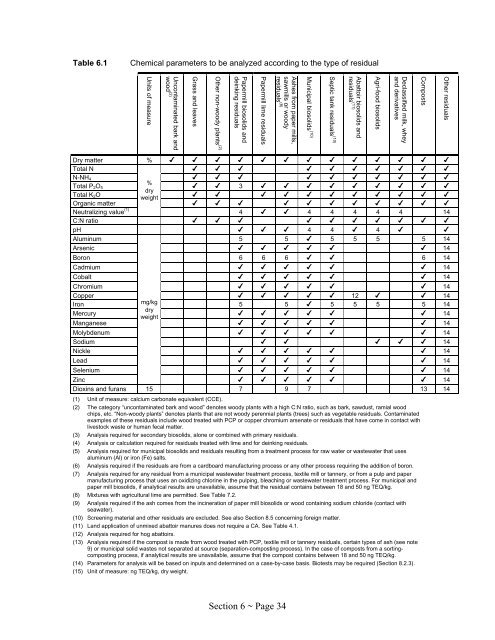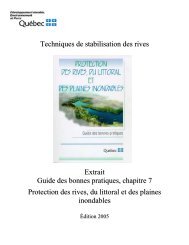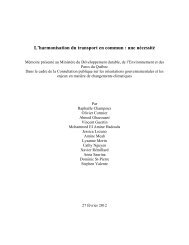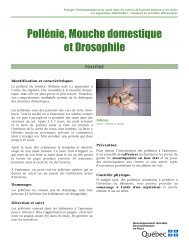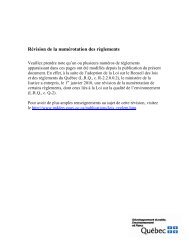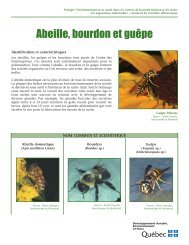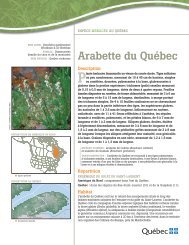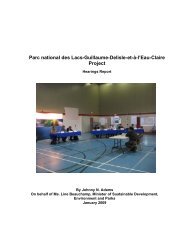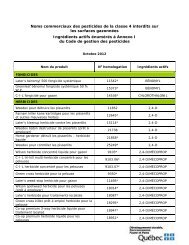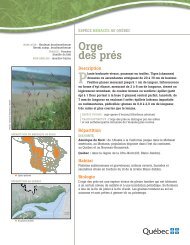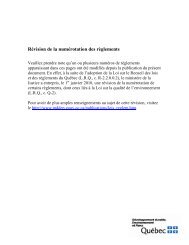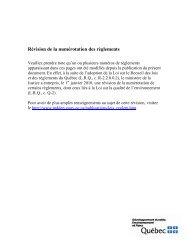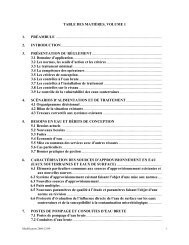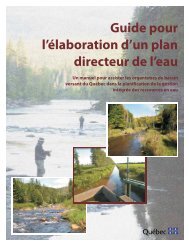Guidelines for the Beneficial Use of Fertilizing Residuals
Guidelines for the Beneficial Use of Fertilizing Residuals
Guidelines for the Beneficial Use of Fertilizing Residuals
You also want an ePaper? Increase the reach of your titles
YUMPU automatically turns print PDFs into web optimized ePapers that Google loves.
Table 6.1 Chemical parameters to be analyzed according to <strong>the</strong> type <strong>of</strong> residual<br />
Units <strong>of</strong> measure<br />
Uncontaminated bark and<br />
wood (2)<br />
Grass and leaves<br />
O<strong>the</strong>r non-woody plants (2)<br />
Papermill biosolids and<br />
deinking residuals<br />
Papermill lime residuals<br />
Dry matter % <br />
Total N <br />
N-NH4<br />
Total P2O5<br />
Total K2O<br />
Organic matter<br />
<br />
<br />
<br />
<br />
<br />
<br />
<br />
<br />
<br />
3<br />
<br />
<br />
<br />
<br />
<br />
<br />
<br />
<br />
<br />
<br />
<br />
<br />
<br />
<br />
<br />
<br />
<br />
<br />
<br />
<br />
<br />
<br />
<br />
<br />
<br />
<br />
<br />
<br />
<br />
<br />
<br />
<br />
<br />
<br />
Neutralizing value (1)<br />
%<br />
dry<br />
weight<br />
4 4 4 4 4 4 14<br />
C:N ratio <br />
pH 4 4 4 <br />
Aluminum 5 5 5 5 5 5 14<br />
Arsenic 14<br />
Section 6 ~ Page 34<br />
Ashes from paper mills,<br />
sawmills or woody<br />
residuals (8)<br />
Boron 6 6 6 6 14<br />
Cadmium 14<br />
Cobalt 14<br />
Chromium 14<br />
Copper 12 14<br />
Iron<br />
Mercury<br />
Manganese<br />
mg/kg<br />
dry<br />
weight<br />
5<br />
<br />
<br />
<br />
<br />
5<br />
<br />
<br />
<br />
<br />
<br />
5<br />
<br />
<br />
5 5 5<br />
<br />
<br />
14<br />
14<br />
14<br />
Molybdenum 14<br />
Sodium 14<br />
Nickle 14<br />
Lead 14<br />
Selenium 14<br />
Zinc<br />
14<br />
Dioxins and furans 15 7 9 7 13 14<br />
(1) Unit <strong>of</strong> measure: calcium carbonate equivalent (CCE).<br />
(2) The category “uncontaminated bark and wood” denotes woody plants with a high C:N ratio, such as bark, sawdust, ramial wood<br />
chips, etc. “Non-woody plants” denotes plants that are not woody perennial plants (trees) such as vegetable residuals. Contaminated<br />
examples <strong>of</strong> <strong>the</strong>se residuals include wood treated with PCP or copper chromium arsenate or residuals that have come in contact with<br />
livestock waste or human fecal matter.<br />
(3) Analysis required <strong>for</strong> secondary biosolids, alone or combined with primary residuals.<br />
(4) Analysis or calculation required <strong>for</strong> residuals treated with lime and <strong>for</strong> deinking residuals.<br />
(5) Analysis required <strong>for</strong> municipal biosolids and residuals resulting from a treatment process <strong>for</strong> raw water or wastewater that uses<br />
aluminum (Al) or iron (Fe) salts.<br />
(6) Analysis required if <strong>the</strong> residuals are from a cardboard manufacturing process or any o<strong>the</strong>r process requiring <strong>the</strong> addition <strong>of</strong> boron.<br />
(7) Analysis required <strong>for</strong> any residual from a municipal wastewater treatment process, textile mill or tannery, or from a pulp and paper<br />
manufacturing process that uses an oxidizing chlorine in <strong>the</strong> pulping, bleaching or wastewater treatment process. For municipal and<br />
paper mill biosolids, if analytical results are unavailable, assume that <strong>the</strong> residual contains between 18 and 50 ng TEQ/kg.<br />
(8) Mixtures with agricultural lime are permitted. See Table 7.2.<br />
(9) Analysis required if <strong>the</strong> ash comes from <strong>the</strong> incineration <strong>of</strong> paper mill biosolids or wood containing sodium chloride (contact with<br />
seawater).<br />
(10) Screening material and o<strong>the</strong>r residuals are excluded. See also Section 8.5 concerning <strong>for</strong>eign matter.<br />
(11) Land application <strong>of</strong> unmixed abattoir manures does not require a CA. See Table 4.1.<br />
(12) Analysis required <strong>for</strong> hog abattoirs.<br />
(13) Analysis required if <strong>the</strong> compost is made from wood treated with PCP, textile mill or tannery residuals, certain types <strong>of</strong> ash (see note<br />
9) or municipal solid wastes not separated at source (separation-composting process). In <strong>the</strong> case <strong>of</strong> composts from a sortingcomposting<br />
process, if analytical results are unavailable, assume that <strong>the</strong> compost contains between 18 and 50 ng TEQ/kg.<br />
(14) Parameters <strong>for</strong> analysis will be based on inputs and determined on a case-by-case basis. Biotests may be required (Section 8.2.3).<br />
(15) Unit <strong>of</strong> measure: ng TEQ/kg, dry weight.<br />
Municipal biosolids (10)<br />
Septic tank residuals (10)<br />
Abattoir biosolids and<br />
residuals (11)<br />
Agri-food biosolids<br />
Declassified milk, whey<br />
and derivatives<br />
Composts<br />
O<strong>the</strong>r residuals


